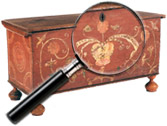|
|
Lucien Dasselborne (1873-1952)
Lucien Dasselborne, French, noted for his work in watercolor as well as oil, was born in Louvroil, France. He exhibited at the Salon des Artistes Francais (receiving an Honorable Mention in 1922, the year after he painted this work), at the Salon de la Societe Nationale, and in 1931, at the Salon d’Automne.
Information courtesy of Cowan’s Auctions Inc.
Fred Darge (American, 1900 to 1978)
Born in Germany and immigrating to the United States in 1923, Fred Darge received his training at two of the most prestigious art schools in the United States: The Art Institute of Chicago and The Art Students League in New York. His first job was a commercial artist, but he was soon unemployed because of the deepening Great Depression. Displaced and out of work, Darge moved to San [...] Click here to continue reading.
Max Danziger (circa 1860 – ?)
The following biographical information is compiled from Artists in Ohio, 1787-1900. Max Danziger, son of Herman Danziger, was born in Prussia about 1860 and was active in Cincinnati from 1880 to at least 1894. He was a portrait and ornamental painter, was listed in 1880 as a “safe-decorator,” and in 1885 as an “artist.” In 1887, he was the proprietor of the Mercantile Art Decorating Company, which offered [...] Click here to continue reading.
Daghestan Rugs
Daghestan means “land of mountains” and encompasses the northeastern region of the Caucasus. Rugs from this area have symmetric knots on wool warps and either wool or cotton wefts. They often feature an all-over or lattice pattern and are found mostly in smaller sizes, especially during the 19th century.
Cupid and Venus Pattern
The Cupid & Venus pattern was produced in the 1870′s and 1880′s by the Richards & Hartley Glass Co. It is found mostly in clear flint glass, but a few amber and vaseline pieces are known. This pattern is sometimes called “Guardian Angel’. The Richards & Hartley glassworks was established in Pittsburgh in 1869 by Joseph Richards and William T. Hartley. They continued manufacturing pressed glass wares until they were [...] Click here to continue reading.
Daniel C. Beard (1850 to 1941)
Daniel C. Beard (1850 to 1941), a Cincinnati native, was best known as one of the founders of the Boy Scouts of America. Before receiving his nickname of ‘Uncle Dan,’ Beard started his career as a civil engineer, working throughout the Cincinnati area. In 1878, his family relocated to New York City where he attended the Art Student’s League, and soon found work illustrating books for Mark Twain [...] Click here to continue reading.
Daguerreotypes
Considered to be the first successful photographic image, the daguerreotype is an image on silverplated copper sensitized with iodine. The plate is then exposed to mercury vapor to produce the image. Early daguerreotypes had an exposure time of up to fifteen minutes; later developments in both the sensitization process and camera lenses reduced this to less than a minute. All daguerreotypes are unique images and produced in the camera rather than from a [...] Click here to continue reading.
Carl Gordon Cutler (1873 to 1945)
American Modernist painter Carl Gordon Cutler is best known for his watercolors of Maine landscapes. Formally trained at the School of the Museum of Fine Arts, Boston, and the Academie Julian in Paris, it was not until the Armory show of 1913 that Cutler was exposed to the more avant-garde artistic movements, such as Cubism and Fauvism. Along with Charles Hovey Pepper, Maurice Prendergast, and E. Ambrose Webster, [...] Click here to continue reading.
Edward Sheriff Curtis (1868-1952)
Born in 1868, Curtis’s photographic career began in 1891 when he purchased a Seattle photographic studio in partnership with Thomas Guptill. Within five years the pair was winning prestigious awards for their work, including a bronze medal from the Photographer’s Association of America. A year later the partnership dissolved.
Curtis remained in the photography business with a strong studio trade and a sideline of nature photography, especially views of Mt. [...] Click here to continue reading.
Frank William Cuprien (1871-1948)
Frank Cuprien is one of Southern California’s most well-known painters. His poetically soft and colorful images of the Laguna Coast at sunset have brought to him notoriety with collectors and scholars. Born in Brooklyn, New York in 1871, he began his studies there and at the Art Students League and the Cooper Institute. Later he studied in Philadelphia. For a time he pursued a simultaneous career in music and [...] Click here to continue reading.
|
Recent Articles
- Charles Alfred Meurer – American Artist & Tromp L’Oeil Artist
- Sendak, Maurice – American Artist & Writer
- Godie, Lee – American Artist
- Davis, Vestie – American Artist
- Bartlett, Morton – American Artist
- Mackintosh, Dwight – American Artist
- Evans, Minnie Jones – African-American Artist
- Mumma, Ed (Mr. Eddy) – American Artist
- Nice, Don – American Artist
- Savitsky, John (Jack) – American Artist
- Gordon, Harold Theodore (Ted) – American Artist
- Dial, Thornton – African-American Artist
- Doyle Sam – American Artist
- Johnson, Lester Frederick – American Artist
- Finster, Howard – American Artist
|
|
